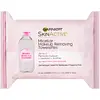What's inside
What's inside
 Key Ingredients
Key Ingredients

 Benefits
Benefits

 Concerns
Concerns

 Ingredients Side-by-side
Ingredients Side-by-side

Water
Skin ConditioningOryza Sativa Cera
Skin ConditioningCopernicia Cerifera Cera
EmollientCera Alba
EmollientStearic Acid
CleansingCandelilla Cera
EmollientTriethanolamine
BufferingPalmitic Acid
EmollientAcacia Senegal Gum
MaskingPanthenol
Skin ConditioningSodium Polymethacrylate
Emulsion StabilisingHydroxyethylcellulose
Emulsion StabilisingPropylparaben
PreservativePEG/PPG-17/18 Dimethicone
EmulsifyingMethylparaben
PreservativeSimethicone
EmollientRayon
Polyquaternium-10
Tocopheryl Acetate
AntioxidantPolycaprolactone
StabilisingWater, Oryza Sativa Cera, Copernicia Cerifera Cera, Cera Alba, Stearic Acid, Candelilla Cera, Triethanolamine, Palmitic Acid, Acacia Senegal Gum, Panthenol, Sodium Polymethacrylate, Hydroxyethylcellulose, Propylparaben, PEG/PPG-17/18 Dimethicone, Methylparaben, Simethicone, Rayon, Polyquaternium-10, Tocopheryl Acetate, Polycaprolactone
Ingredients Explained
These ingredients are found in both products.
Ingredients higher up in an ingredient list are typically present in a larger amount.
Panthenol is a common ingredient that helps hydrate and soothe the skin. It is found naturally in our skin and hair.
There are two forms of panthenol: D and L.
D-panthenol is also known as dexpanthenol. Most cosmetics use dexpanthenol or a mixture of D and L-panthenol.
Panthenol is famous due to its ability to go deeper into the skin's layers. Using this ingredient has numerous pros (and no cons):
Like hyaluronic acid, panthenol is a humectant. Humectants are able to bind and hold large amounts of water to keep skin hydrated.
This ingredient works well for wound healing. It works by increasing tissue in the wound and helps close open wounds.
Once oxidized, panthenol converts to pantothenic acid. Panthothenic acid is found in all living cells.
This ingredient is also referred to as pro-vitamin B5.
Learn more about PanthenolSimethicone is a silicone. It is an emollient and used to reduce foaming in a product. It is also often used to coat sunscreen ingredients for better spreadability.
This ingredient is created by mixing dimethylpolysiloxane and hydrated silica.
Water. It's the most common cosmetic ingredient of all. You'll usually see it at the top of ingredient lists, meaning that it makes up the largest part of the product.
So why is it so popular? Water most often acts as a solvent - this means that it helps dissolve other ingredients into the formulation.
You'll also recognize water as that liquid we all need to stay alive. If you see this, drink a glass of water. Stay hydrated!
Learn more about Water